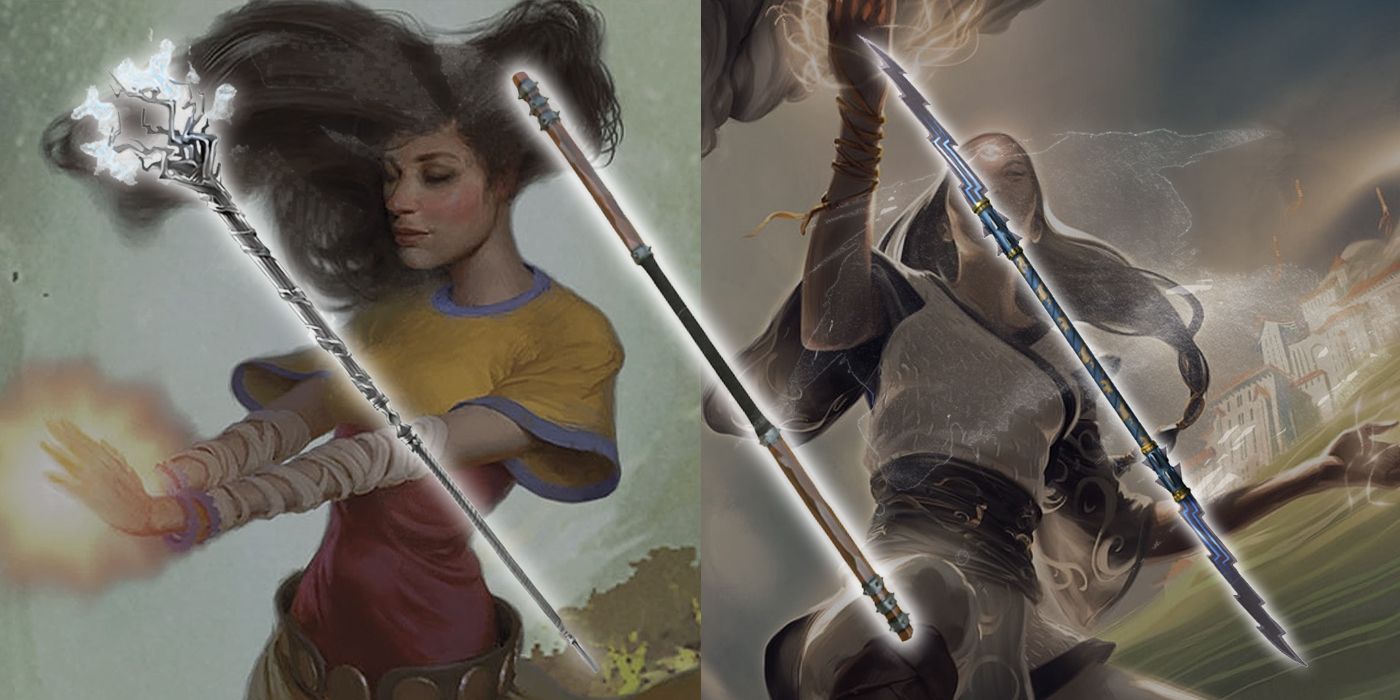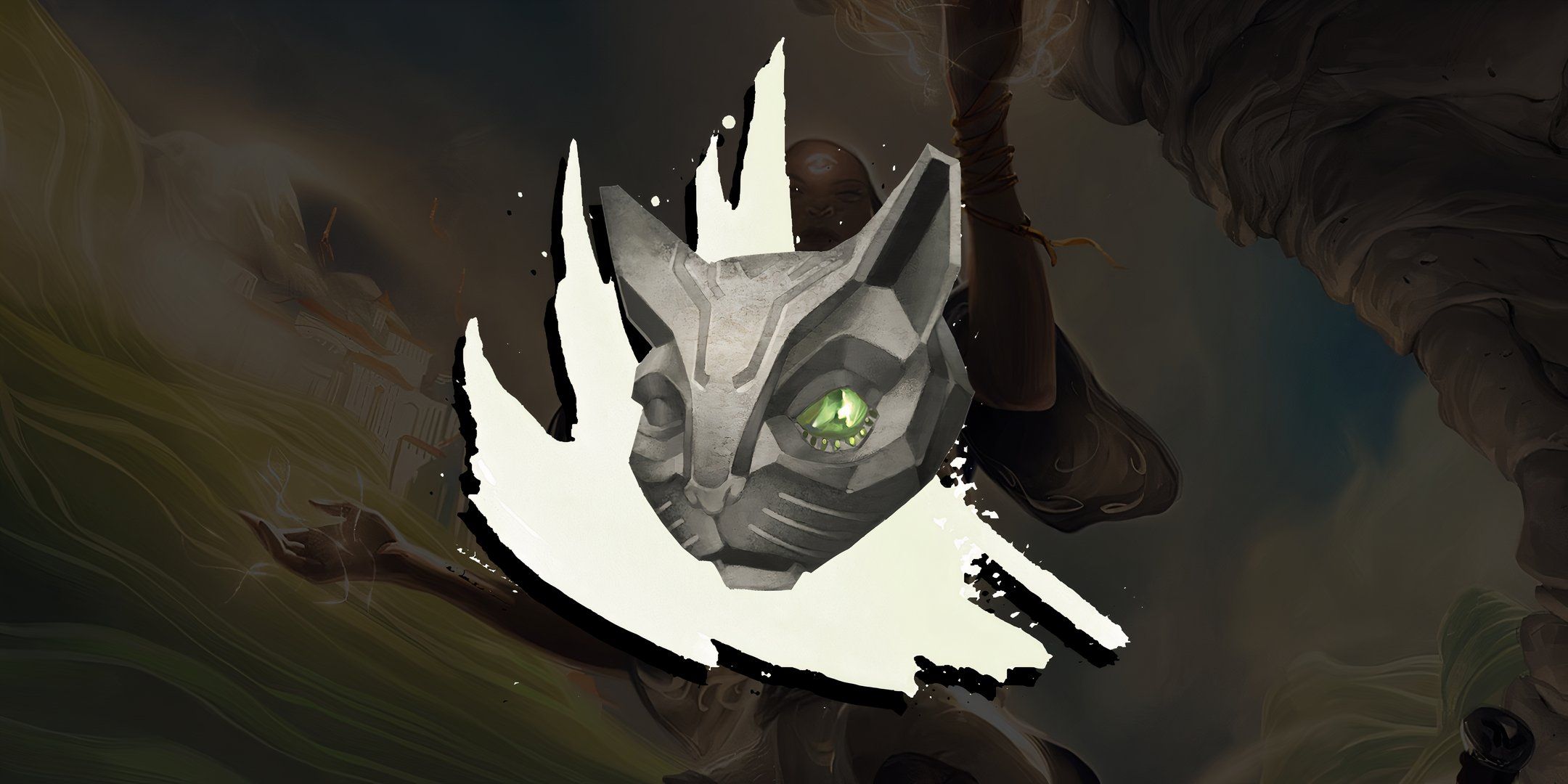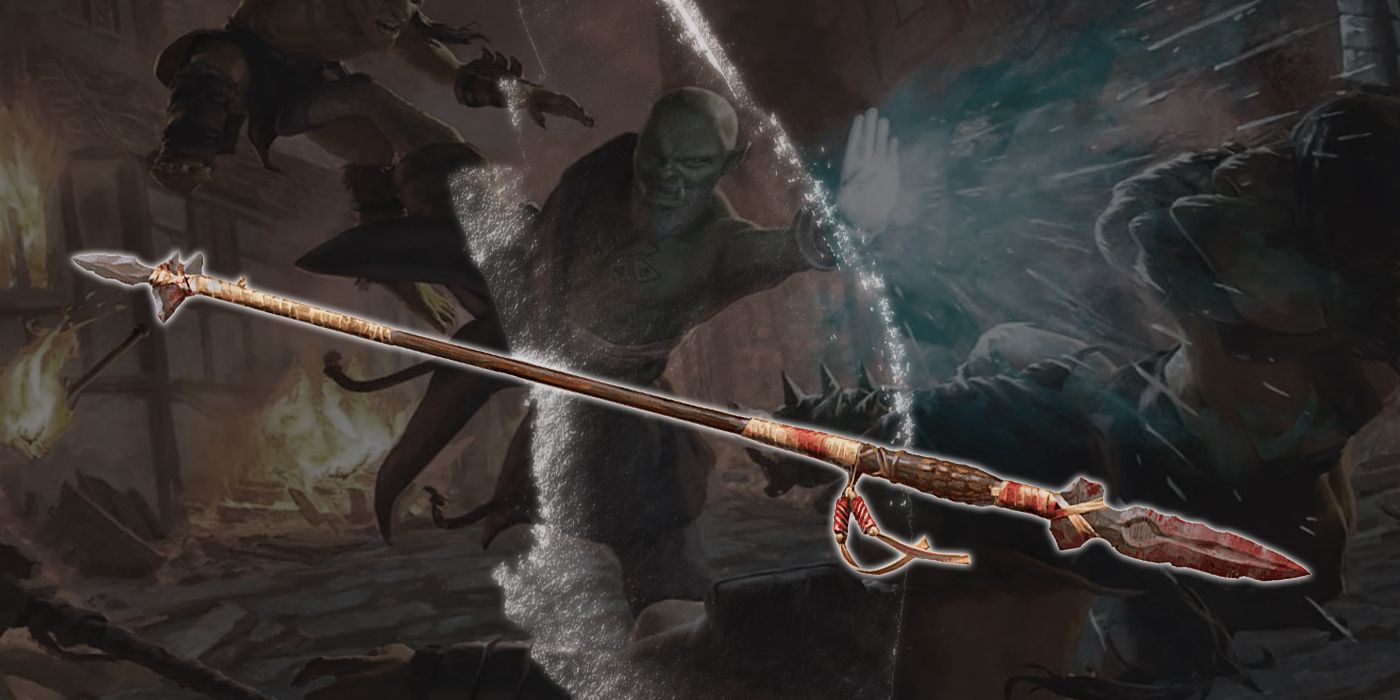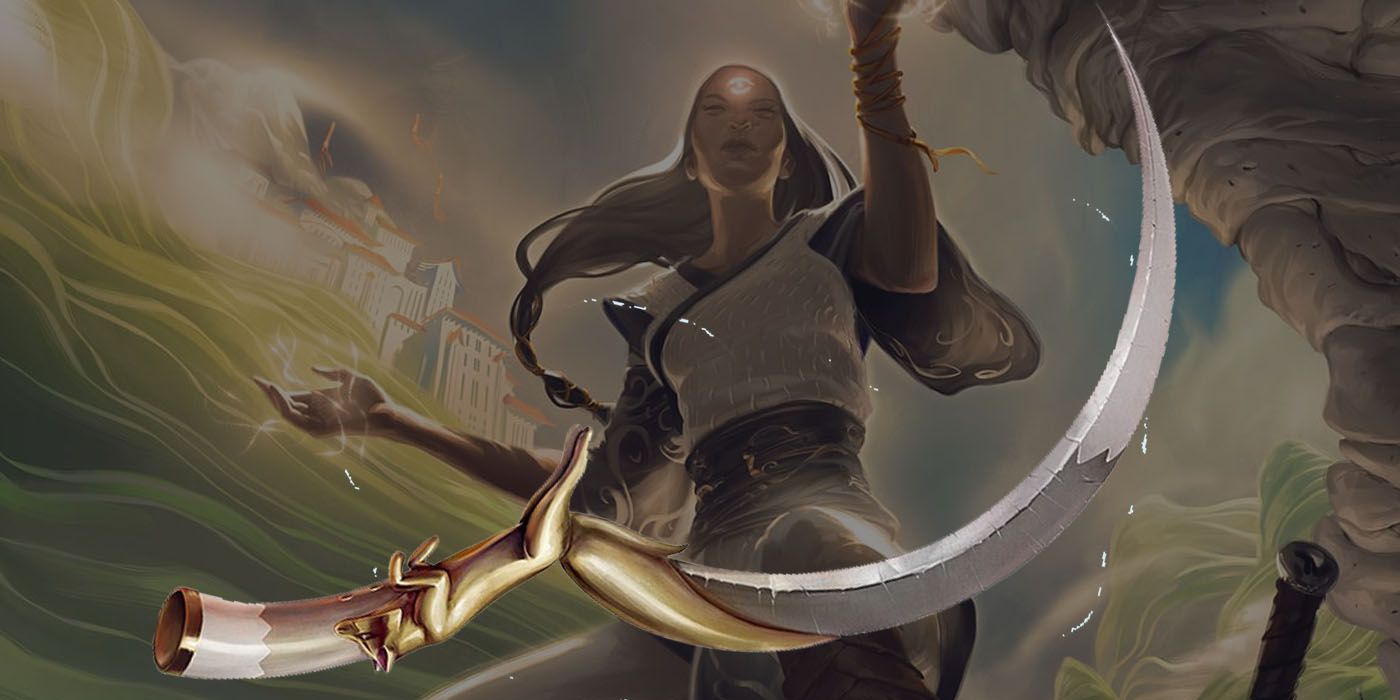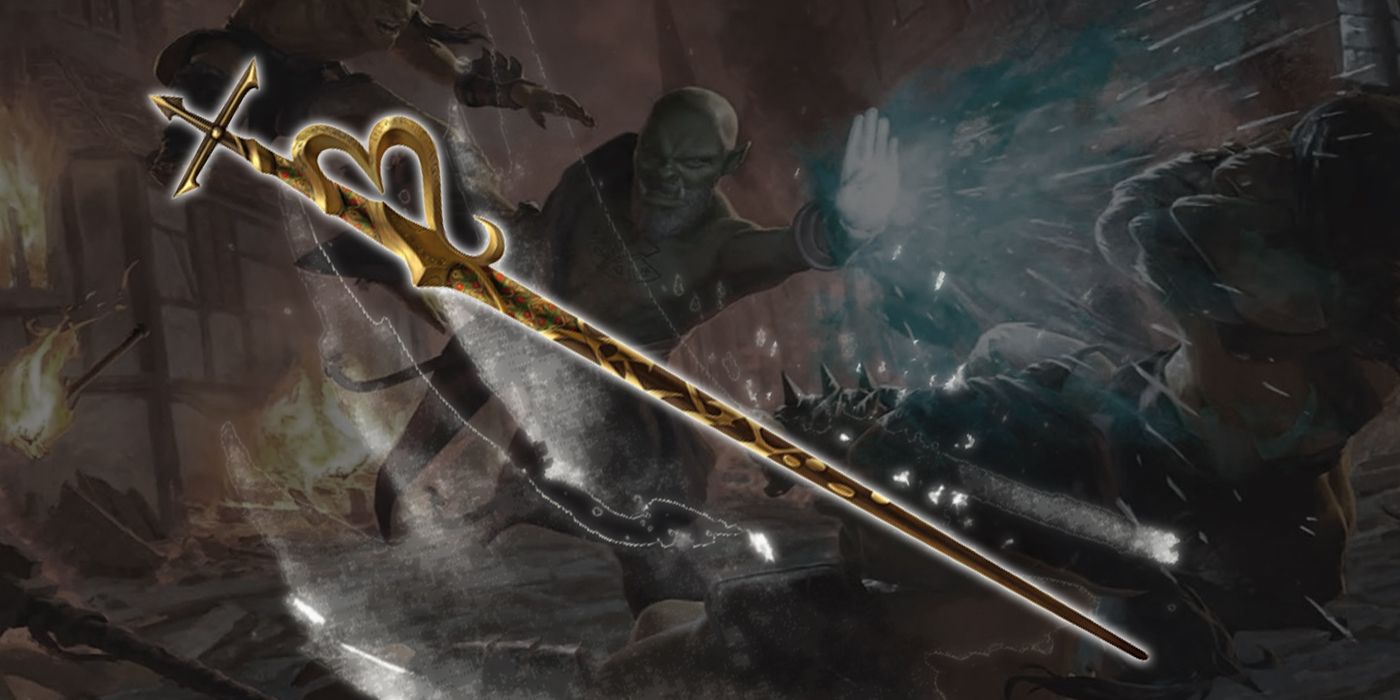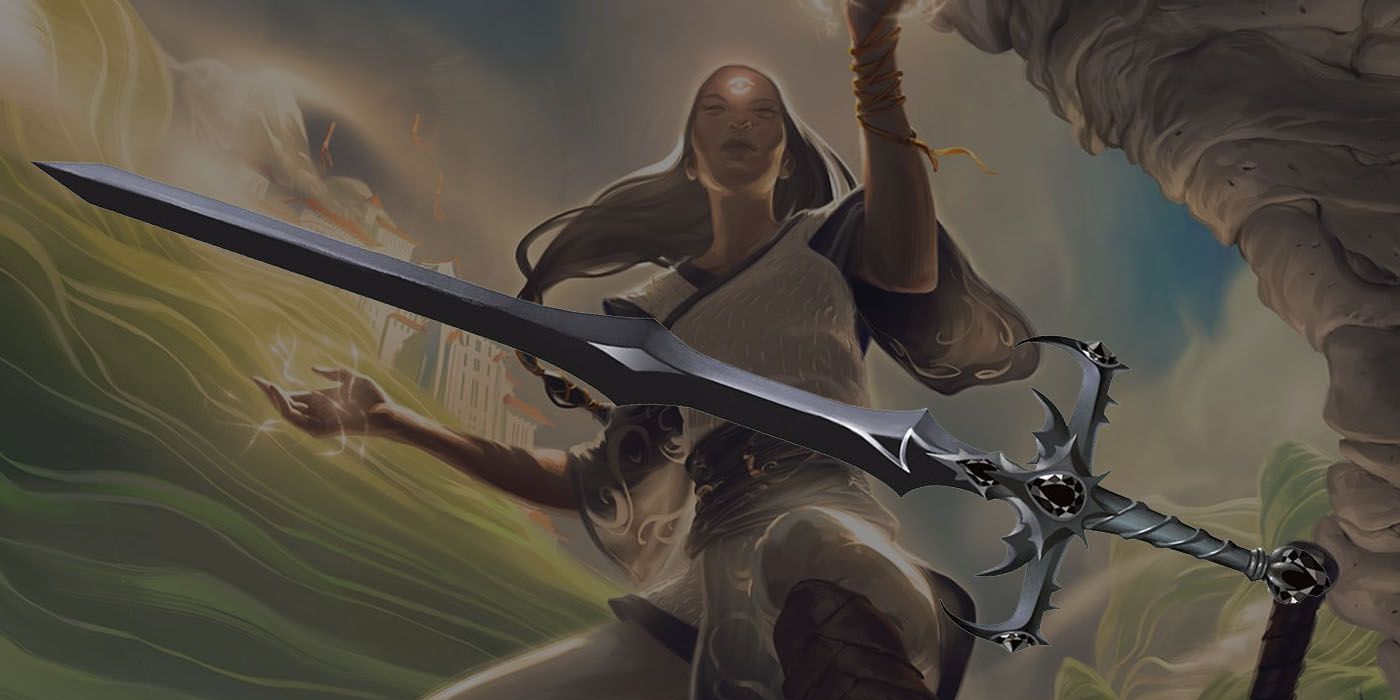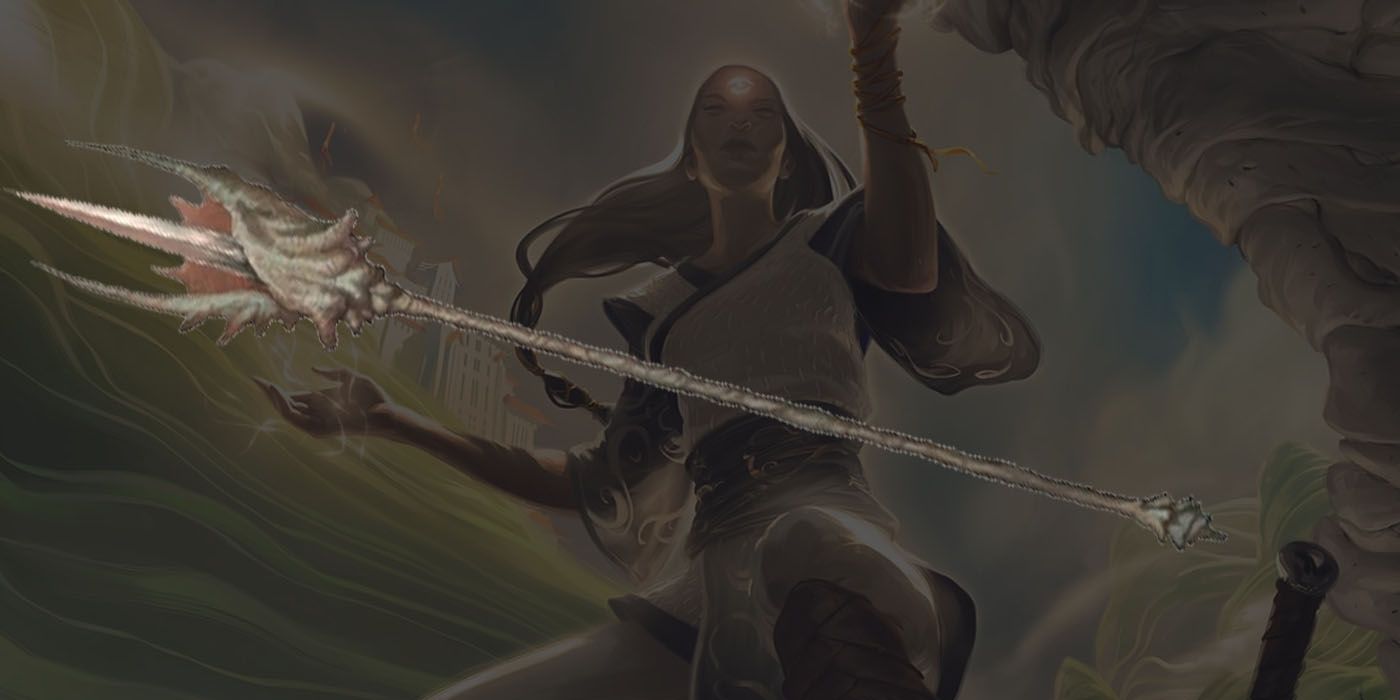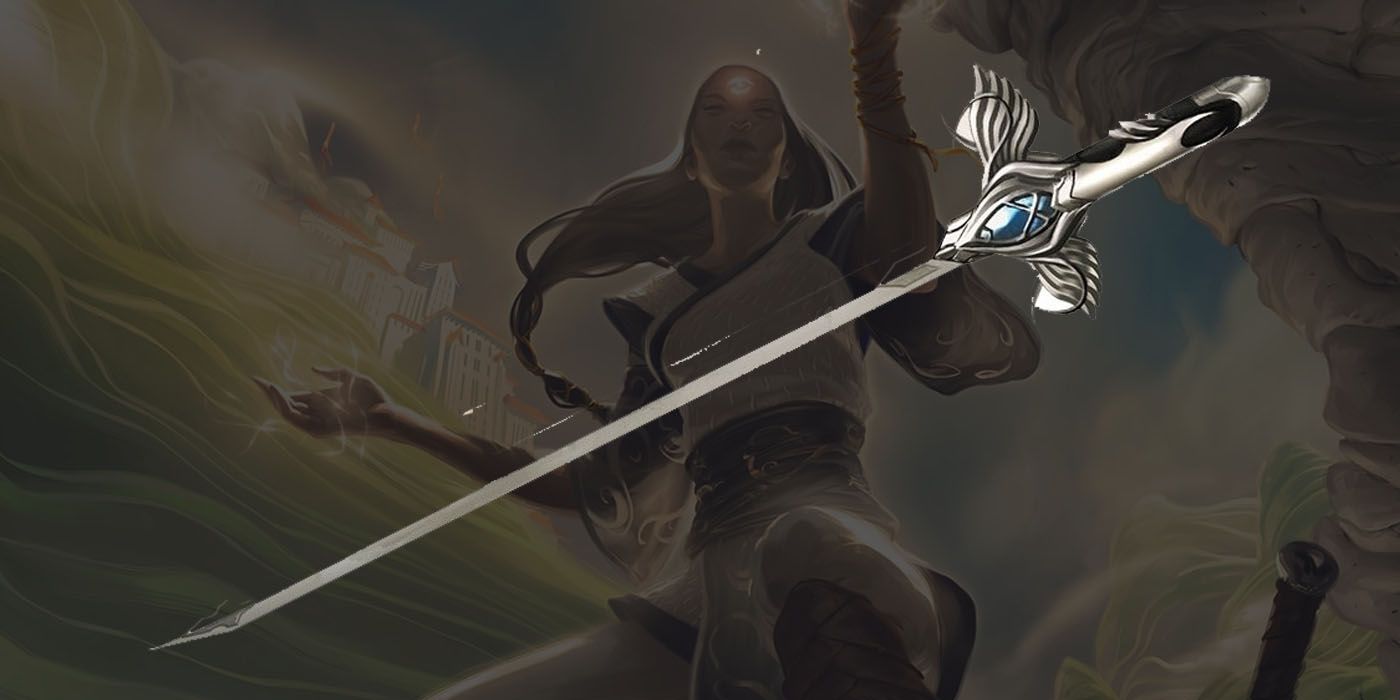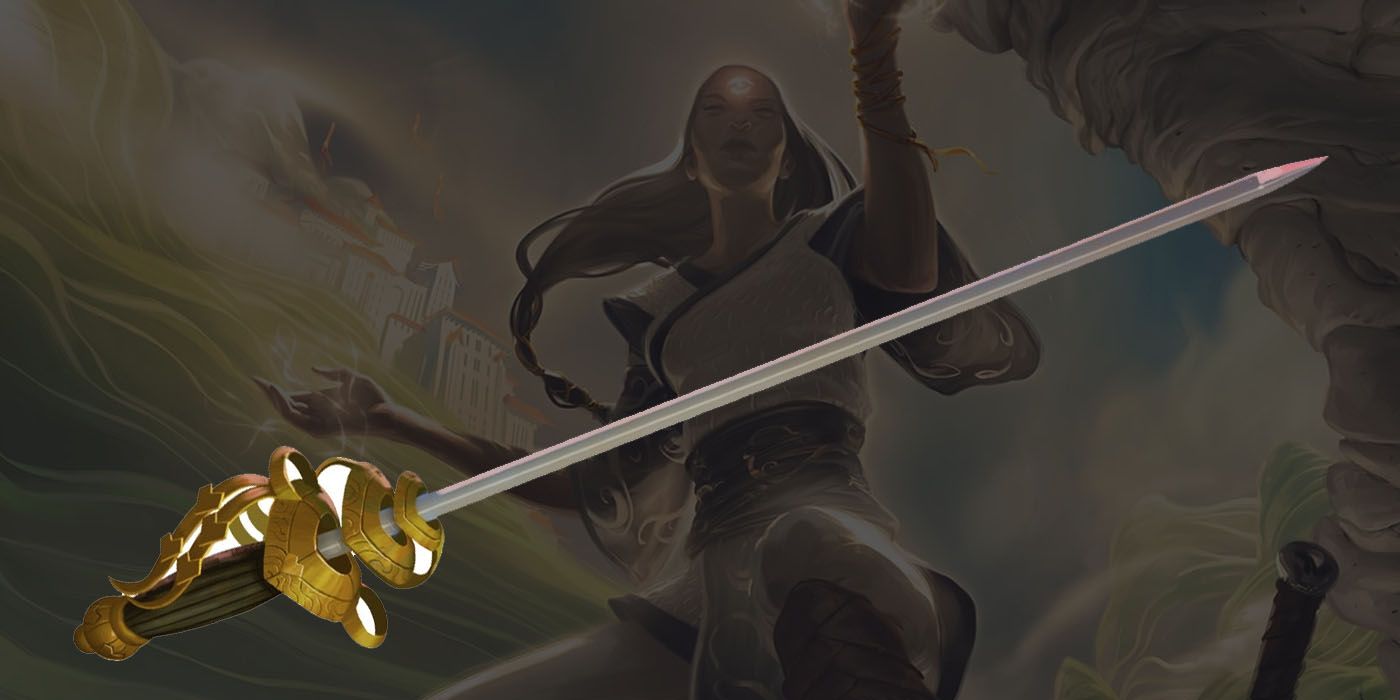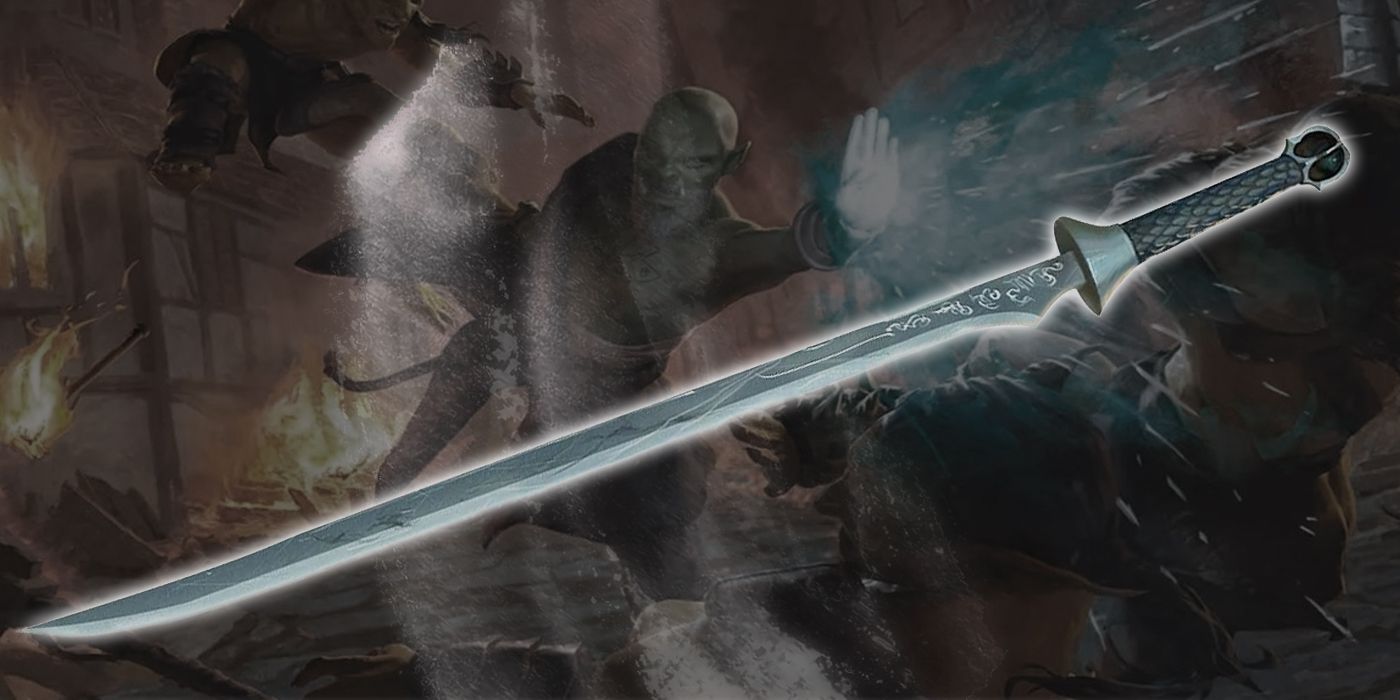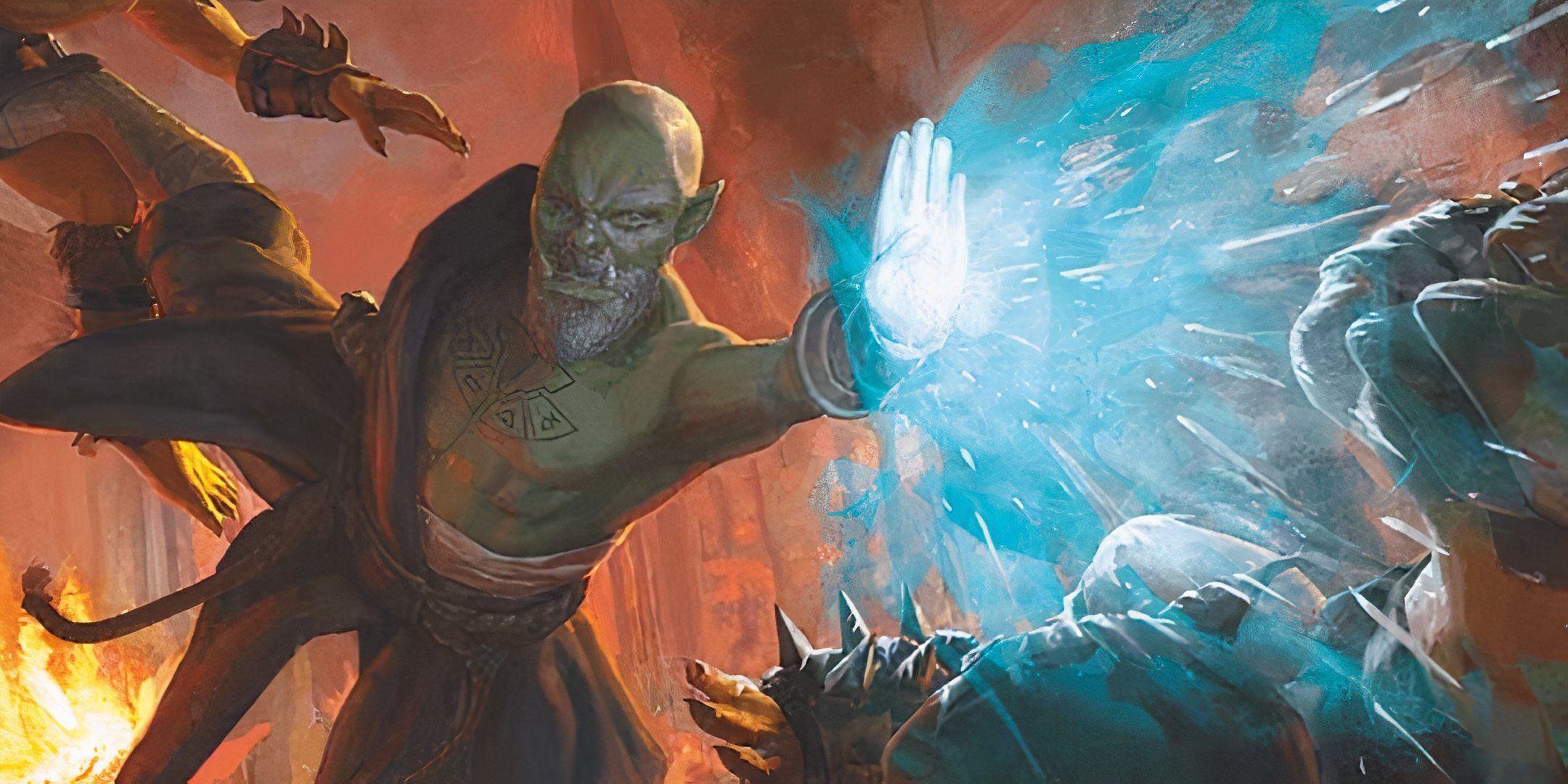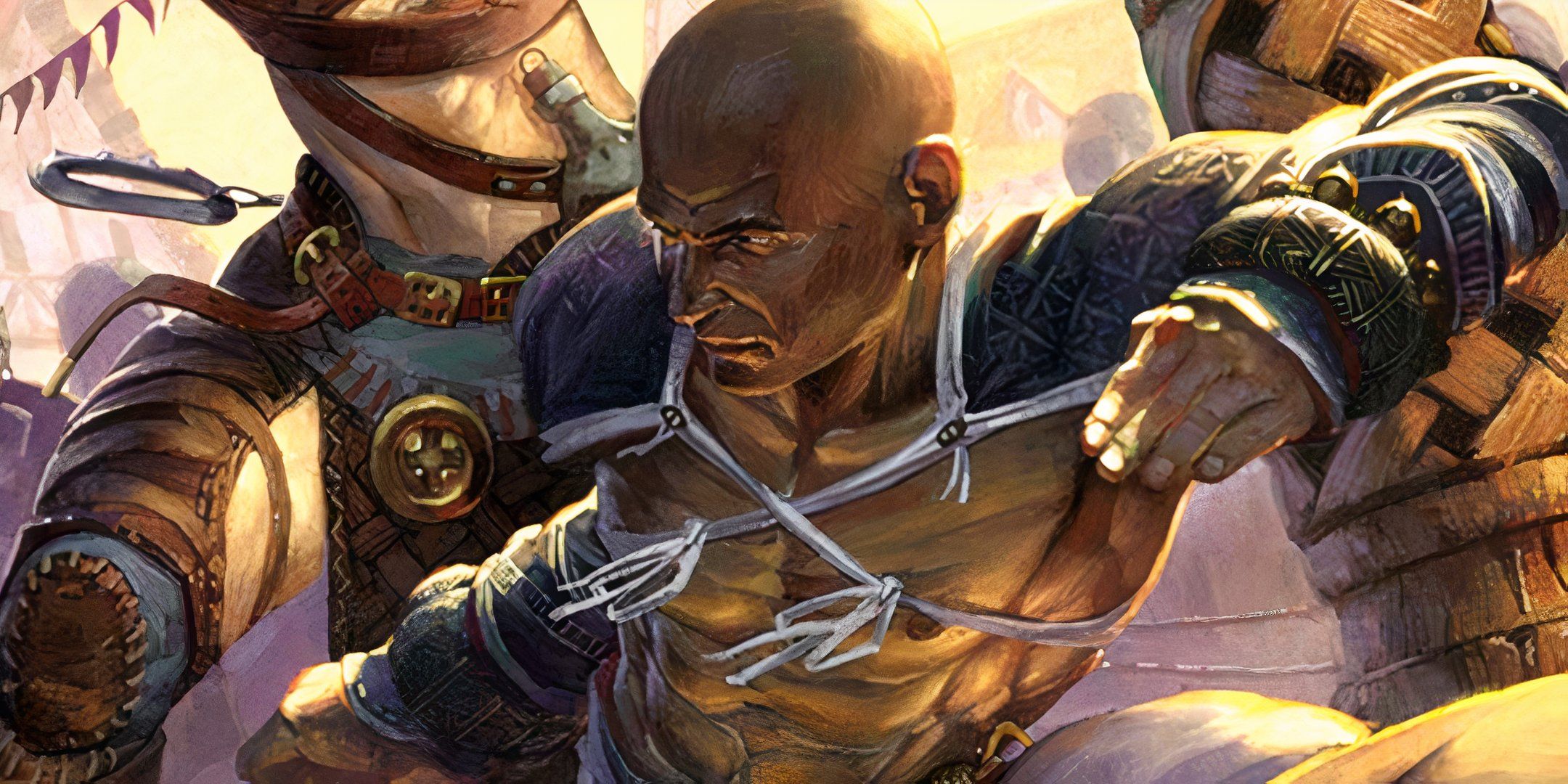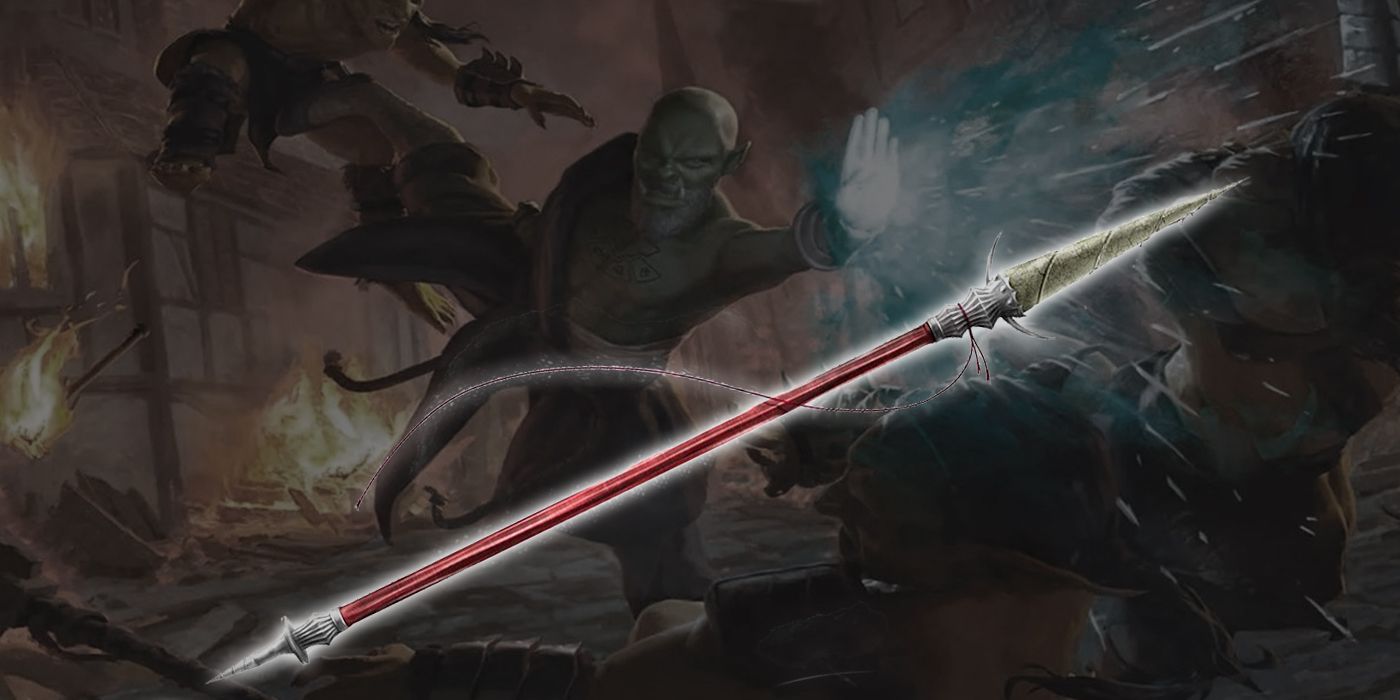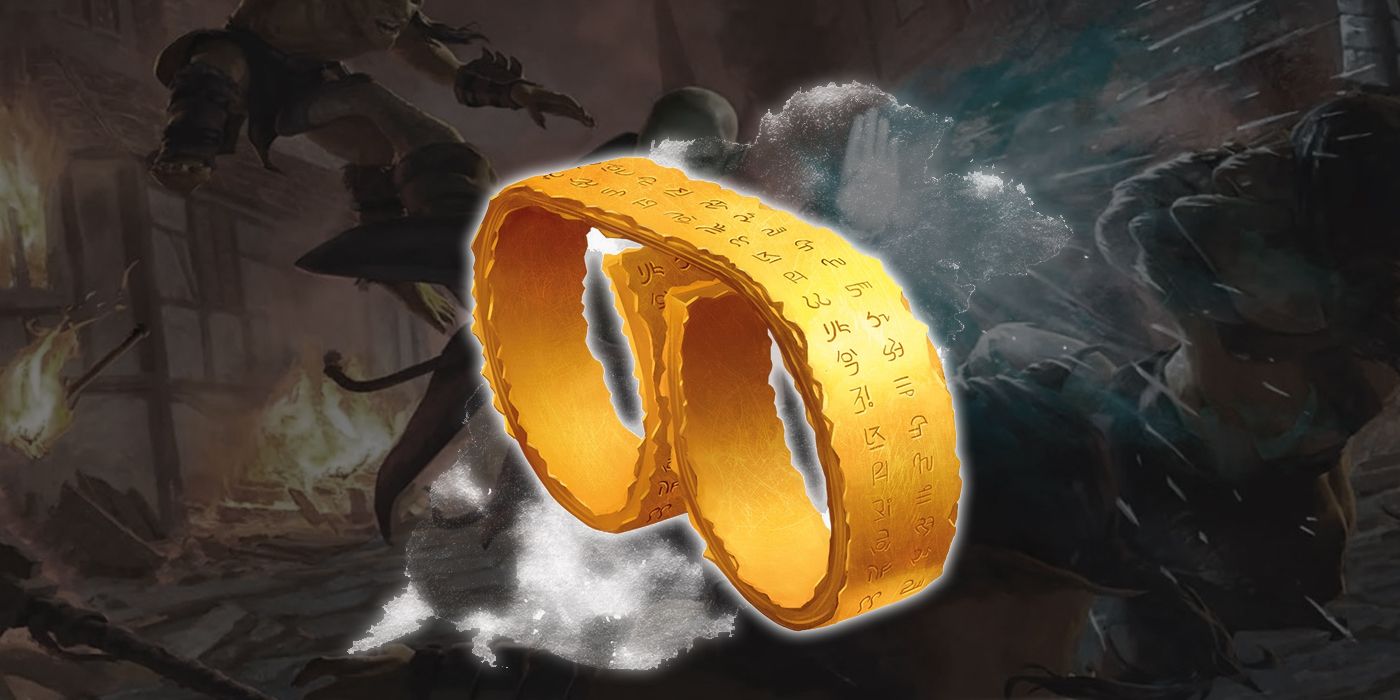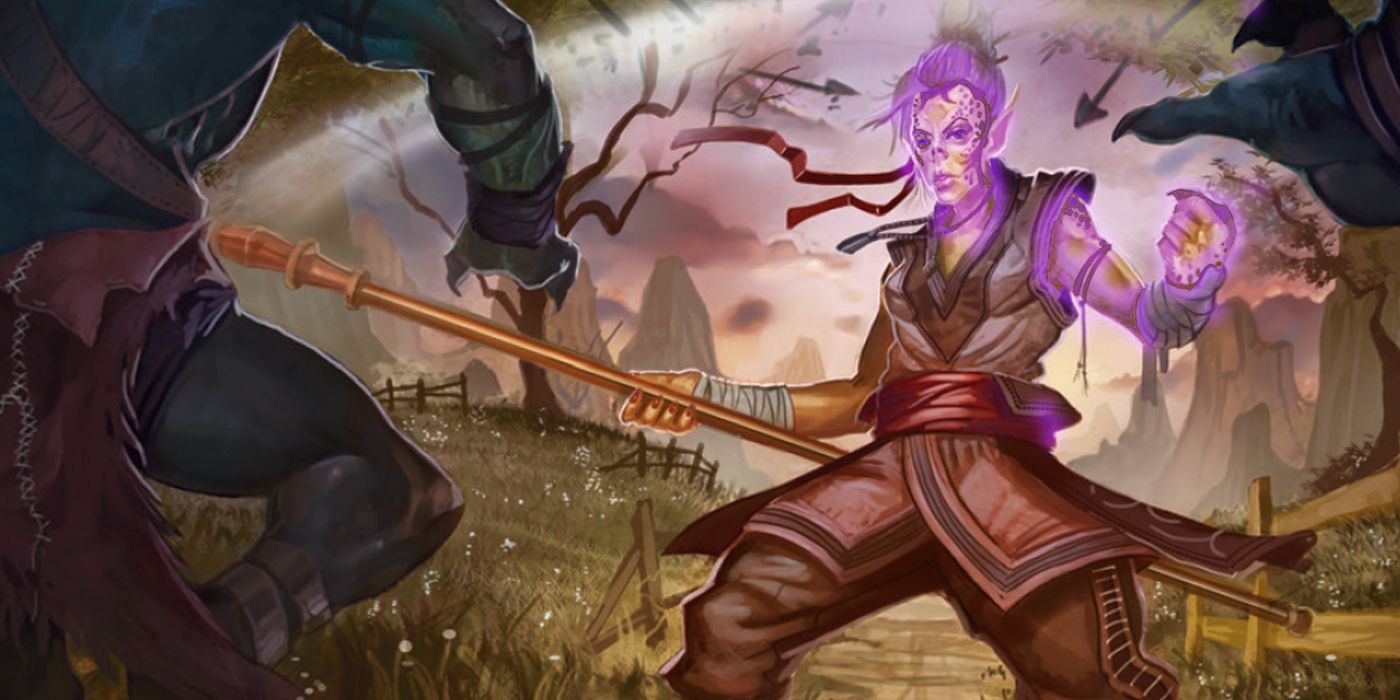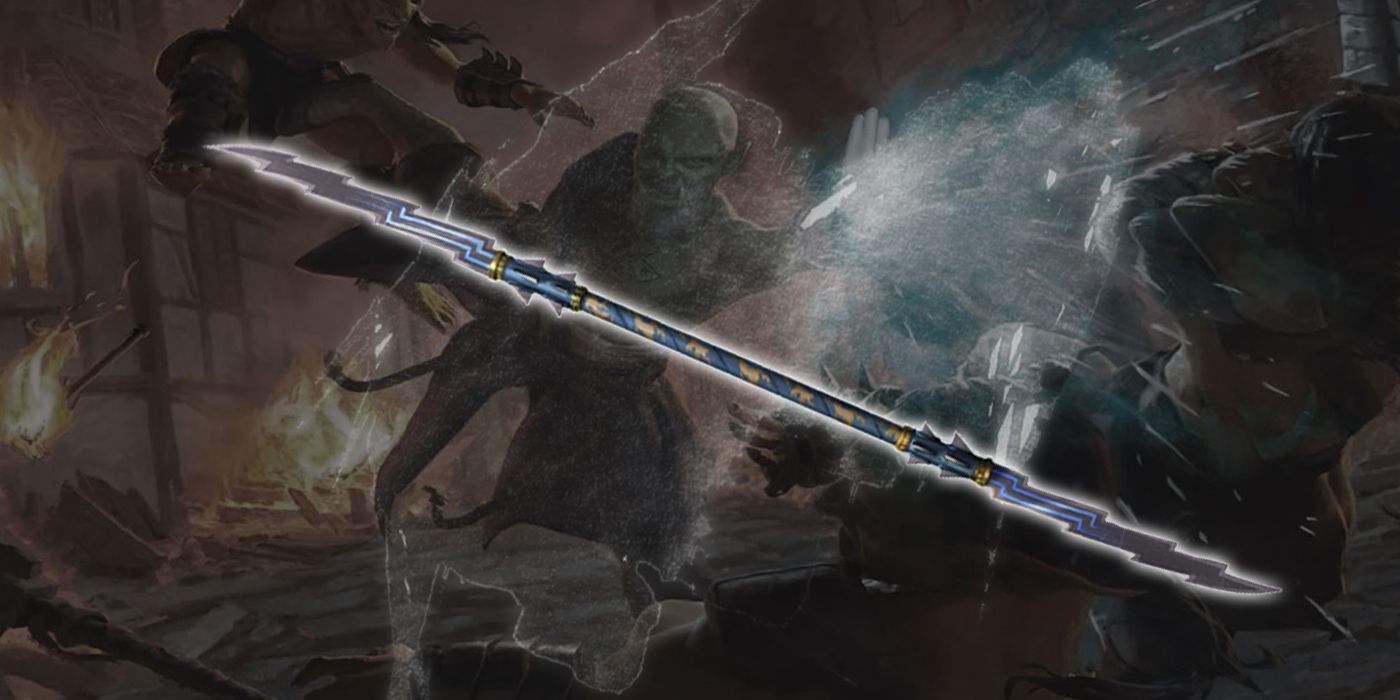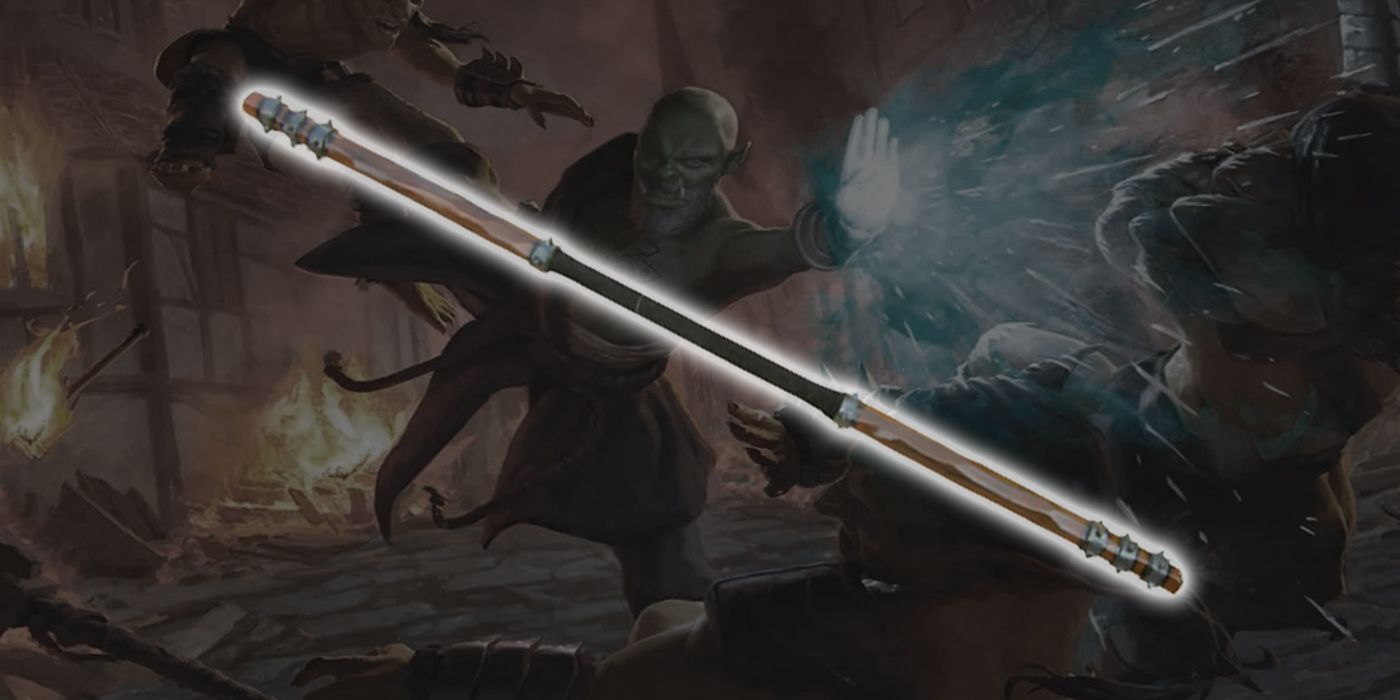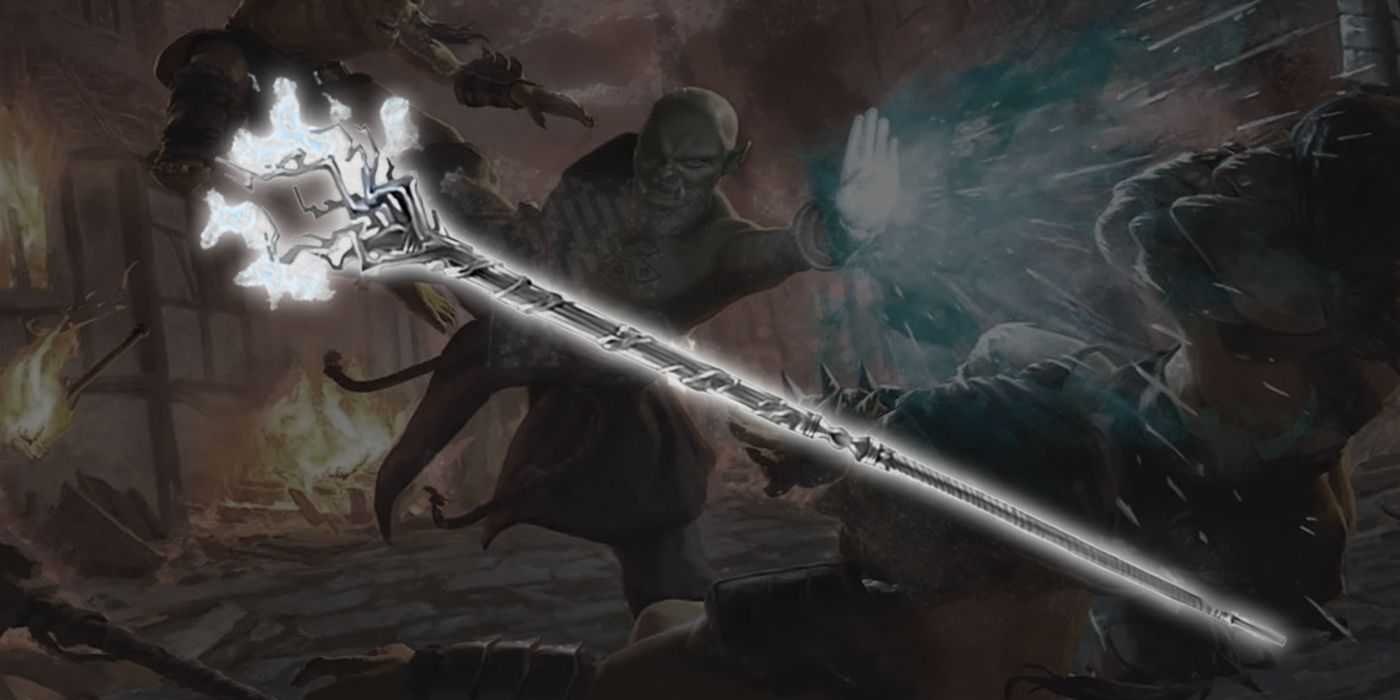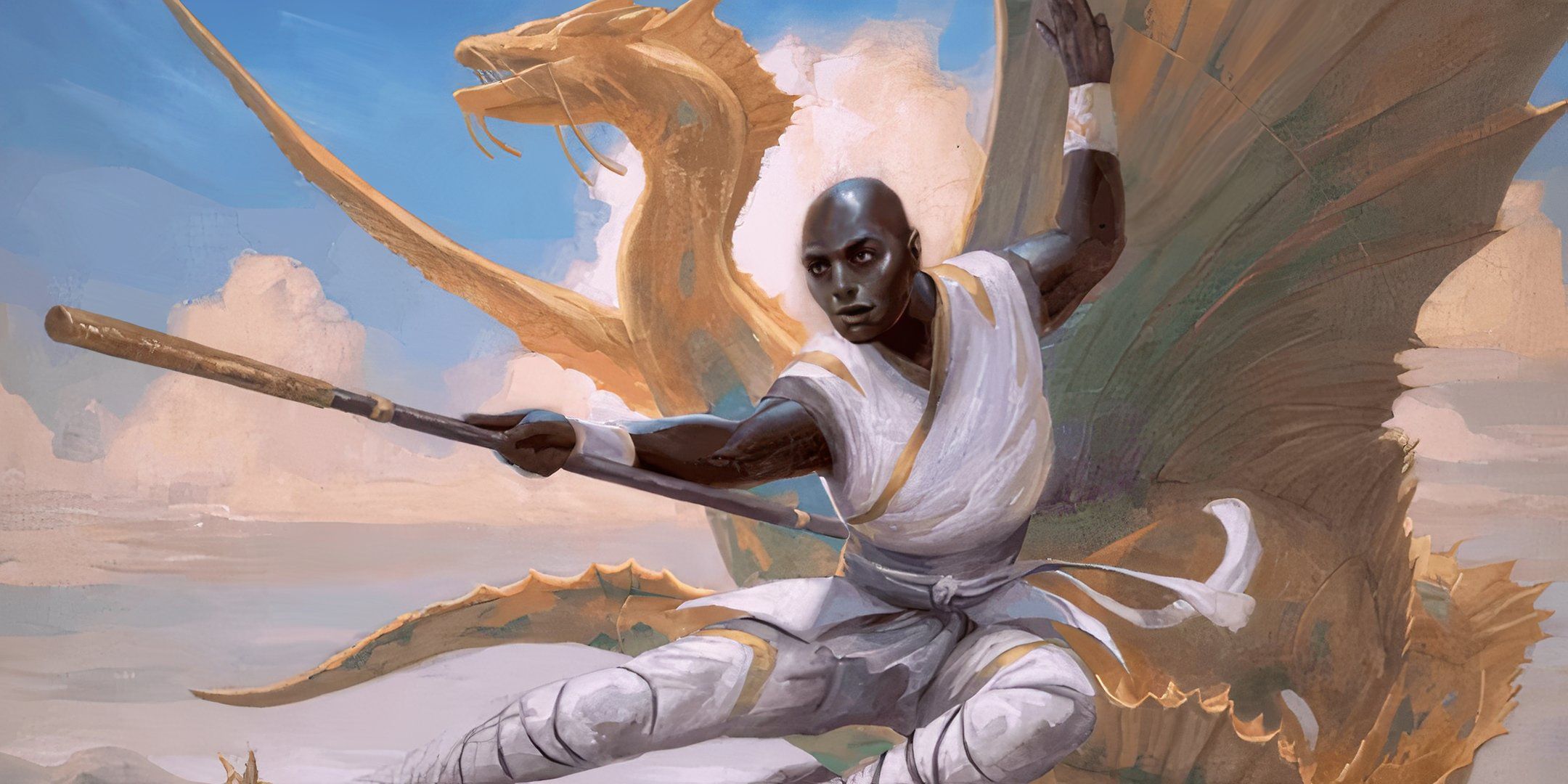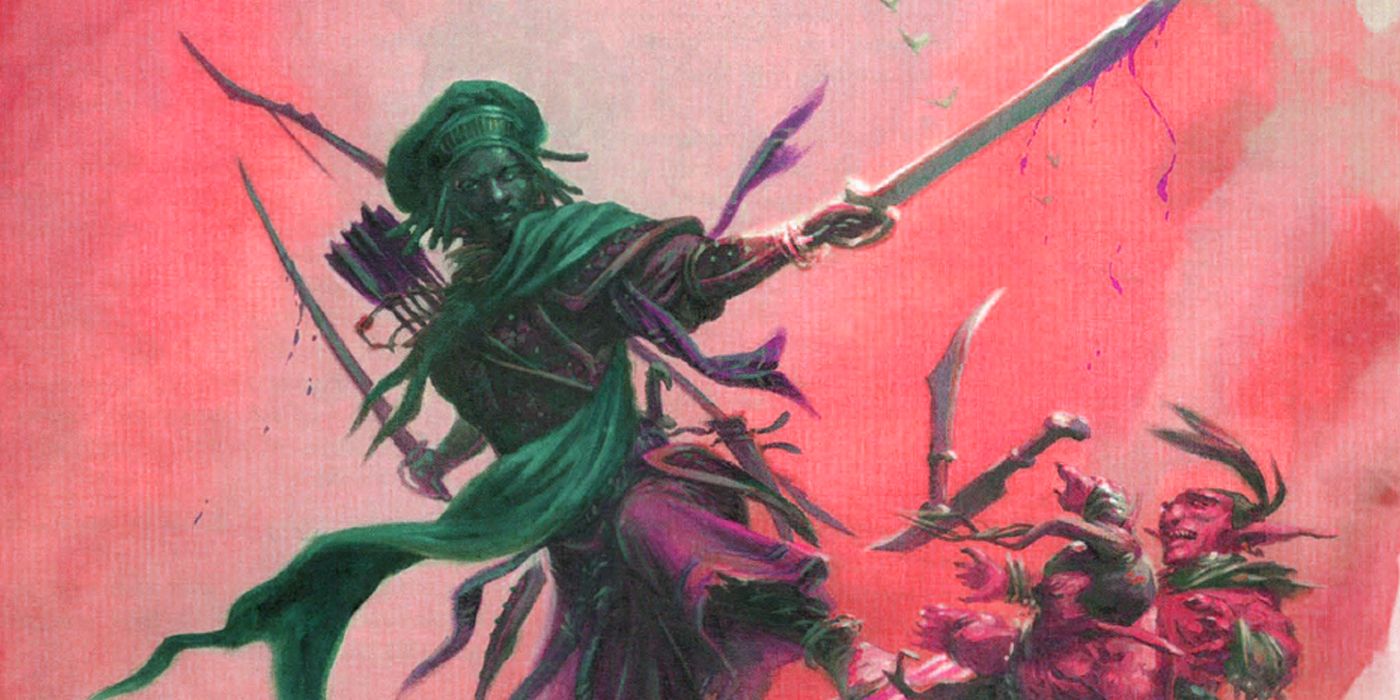Highlights
- Monks can use their very bodies as weapons, with maneuvers that can transform their attacks into devastating blows.
- Well-trained Monks can specialize in using armaments as extensions of their bodies, enhancing their martial prowess.
- Obtaining the right magical item can help Monks wield tremendous powers and live the life of heroes in martial arts fiction.
Monks in Dungeons & Dragons remain the staple martial artists - their very bodies are weapons, and their complicated maneuvers can transform their punches, kicks, throws, and lunges into devastating attacks. Well-trained Monks aren't averse to weapons training, though, as some Monks do specialize in using armaments as extensions of their bodies.

The Best Ways To Play Dungeons & Dragons Online
In recent years, more and more people have begun playing D&D online. There are plenty of tools to help with this endeavor – here are some of the best.
With the right weapon, a Monk in D&D 5e can obliterate swaths of enemy forces. Obtaining the right Magic Item can help Monks wield tremendous magical powers or live the life of heroes in martial arts fiction. A Monk with the right weapon and the right backstory to match can easily become the stuff of legends.
Updated on June 5th, 2024, by Rhenn Taguiam: With Dungeons & Dragons celebrating its 50-year Anniversary in 2024, fans of the acclaimed TTRPG might be curious as to how upcoming releases such as the updated Player’s Handbook can make an impact on their adventures and campaigns. However, fans looking forward to the updated PHB may want to continue creating their dream builds, especially fast-attacking and mobile Monks who can adapt to encounters courtesy of their quick feet and combat options. Part and parcel of this theorycraft involves finding the best armaments to provide their Monk, especially if they want to pull off more complex stunts and maximize features such as Flurry of Blows and other attacks. Among must-try weapons include wraps that transform one’s fists into magical armaments, claws resembling those of a mole, and even gauntlets designed specifically to defeat beasts, all of which are now included on this list following its latest update.
19 Stone Of Good Luck
Perfect For Skills-Heavy, Ability-Heavy Toolkits
Rarity | Uncommon (Requires Attunement) |
|---|---|
Weapon Type | Adventuring Gear (Wondrous Item) |
Bonus | - |
Effects | Saving Throws +1, Ability Checks +1 |
Monks enjoy their Dungeons & Dragons gameplay not just for their arsenal of multi-attack options, but also for how they open up encounters to dynamic gameplay options. It’s thematically plausible for a Monk to leap past walls to make an aerial downward attack against an enemy, and the possible Athletics (STR) Check required to do so is more plausible with the Stone of Good Luck.
When acquired, the Stone bestows upon the Monk +1 to both Ability Checks and Saving Throws. At first glance, this incentivizes the Monk’s ability to explore the environment, as the aforementioned boost can increase their chances of surviving traps and fatal encounters. However, the Stone can also work in combat as a nifty buff when defending against Spells or for facilitating Class gimmicks.
How To Get Stone Of Good Luck
The Stone of Good Luck is described as a simple polished agate, and its Uncommon nature means it shouldn’t be too difficult to find for Monks. This could come in the form of an heirloom passed down by their master or their family, or an item that “called” their attention in the ruins of a temple or a village.
Stone Of Good Luck: How Does It Fit The Monastic Warrior?
While not necessarily a “weapon” that boosts the Monk’s overall DPS, the Stone of Good Luck bolsters their potential for utility. Players need to remember that stunts they see in action flicks or even wuxia series where Monks attempt to leap across buildings or scale structures to attack opponents aren’t necessarily impossible in DnD combat. Should they ask their Dungeon Masters about the plausibility of such stunts, it’s possible that they will require them to do an Ability Check - allowing the Stone of Good Luck to shine. On the off-chance that this stunt won’t consume an Action, and instead only cost Movement, such a maneuver could even lead to an awesome display of fighting prowess.
18 Spear
Traditional Melee Weapon With Reach
Rarity | Common |
|---|---|
Weapon Tree | Simple |
Bonus | - |
Effects | 1d6 Piercing, Thrown, Range (20/60), Versatile (1d8) |
As a Simple Melee Weapon, anyone in D&D can hold and use a Spear, which makes it surprising for Monks to almost always want a Spear on the get-go. Spears deal 1d6 Piercing Damage, which makes them just a bit less threatening than the staple Longsword. Thankfully, Spears have a 20/60 Range, giving Monks more legroom in terms of distance.
While the Spear seems simplistic enough, it does shine with its other properties. As a Versatile weapon, wielding the Spear two-handed will land 1d8 damage. Its Thrown property also gives Monks an emergency throwing weapon. At a lack of Magic Items, a Spear's properties can replace a Monk's Unarmed Strikes until they get 1d10 damage at 17th-level. Spears can be found almost anywhere.
How To Get Spear
Because the Spear is a simple and common fantasy weapon, characters may begin with the Spear as part of their initial arsenal. Those looking for a Spear in their sessions may find them with the most armed foes or even the local blacksmith for a relatively low price.
Spear: How Does It Fit The Monastic Warrior?
Easily the best starting weapon and emergency weapon of choice for Monks, the Spear’s Versatile Property should give the Class the flexibility of 1d6/1d8 at 1H and 2H options. The 1d8 Damage alone gives Monks the best damage output prior to 17th-Level, which is the only time their Unarmed Strikes deal 1d10 Damage.
17 Moon Sickle
Perfect For Ranger, Druid Multiclass Setups
Rarity | Uncommon, Rare, Very Rare (Requires Attunement by a Druid, Ranger) |
|---|---|
Weapon Tree | Sickle |
Bonus | +1, +2, +3 to Attack, Damage Rolls |
Effects | When holding the weapon:
|
While the lore dictates that the Moon Sickle be only Attuned to a Druid or Ranger, a Dungeon Master can homebrew a Moon Sickle for a Monk under special circumstances. For instance, Monks particularly attached to orders or monasteries with links to nature may be given exceptions to wield a Moon Sickle, with its properties converted for Monks instead.
In that regard, a homebrew Moon Sickle could give a Monk bonus to both Attack and Damage Rolls, as well as a bonus to Spell Attack Rolls and Saving Throw DCs for their Spells. Not only that, but the Moon Sickle may be able to act as a Spellcasting Focus for their Spells. As an added bonus, holding the Sickle while casting a healing spell can add 1d4 worth of healing to the remedy provided, which is a nifty bonus.
How To Get Moon Sickle
Sickles aren’t often associated with Monks, making the Moon Sickle a unique companion to the martial artist. In that regard, a Monk wanting such a weapon must be able to acquire it through unconventional means to support the armament’s uncommon nature. A Monk could be awarded a Moon Sickle after helping the Druid of a neighboring forest or could acquire one during a visit to an elven city.
Moon Sickle: How Does It Fit The Monastic Warrior?
Despite not being a Druid or a Ranger, the Moon Sickle makes for an attractive Monk Weapon given its nature as a Simple Weapon. Its base 1d4 Slashing augmented with attack/damage bonuses based on the Moon Sickle’s rarity could boost its base damage potential. Taking the Very Rare variant with a +3 bonus could make the Moon Sickle a viable replacement for Unarmed Strikes until 5th-Level when its damage dice goes to 1d6, or until 10th-Level when it fully transitions into a more optimal 1d8. Multiclassing into a Druid gives the Monk more spellcasting options while dipping into the Ranger can give the Monk some terrain and opponent-based advantages.
16 Staff Of Adornment, Birdcalls, Flowers
Extra Illusory Effects Add Flavor To Quarterstaff
Rarity | Common |
|---|---|
Weapon Tree | Staff |
Bonus | - |
Effects | Staff of Adornment
Staff of Birdcalls
Staff of Flowers
|
Regardless of the type (Adornment, Birdcalls, Flowers), this Staff works exactly like a usual Quarterstaff. It deals 1d6 Bludgeoning damage that becomes 1d8 when wielded two-handed via Versatile. Many of its extra magical effects work more like fluff, which can improve the theme of the Monk. And as a Magic Weapon, it does work past resistance to non-magical attacks.
Monks who want a weapon with better extra effects could work with other longswords. However, wielding the Staff of Adornment two-handed does give much-needed 1d8 base damage.
How To Get Staff Of Adornment, Birdcalls, Flowers
Players and DMs can have the resident Monk acquire any of these staves in similar ways. As staves associated with nature, a Monk could be granted any of these staves as a prize for solving a problem in the Feywild or for helping the local Druids resolve a conflict with the city intruding in their lands.
Staff Of Adornment, Birdcalls, Flowers: How Does It Fit The Monastic Warrior?
The appeal of these staves in a combative sense lies not in their effects, but their base properties. Without their effects, any of these staves become Quarterstaff +1, dealing 1d6+1 Bludgeoning damage on hit. When used creatively, these staves’ effects could potentially distract opponents, leaving them wide open for surprise attacks.
15 Sword Of Vengeance
Edgier Variant Of A +1 Weapon
Rarity | Uncommon (Requires Attunement) |
|---|---|
Weapon Tree | Any Sword |
Bonus | +1 to Attack, Damage Rolls |
Effects | Curse:
|
Monks are trained by their respective monasteries not to only use their bodies and minds as weapons, but to be the truest models of discipline and patience. Usually, a Monk wouldn’t want to exert their emotions in combat. However, a Monk wielding a Sword of Vengeance can be a unique combo.
Inherently cursed, a Monk with the Sword will be unwilling to part with it and will have a Disadvantage on Attacks with weapons other than the Sword. Moreover, whenever the Monk is damaged, they need to succeed in a DC 15 Wisdom Save, or else they go into a frenzy and attack the monster that dealt this damage to them. Being a Magic Item, the Sword of Vengeance confers a +1 Bonus to Attack and Damage Rolls.
How To Get Sword Of Vengeance
Being one of the more standalone Magic Items, the Sword of Vengeance can find itself in a multitude of situations. However, it’s probably more interesting to attach the weapon to a setting that fits its theme. For instance, the Sword of Vengeance may be a cursed weapon that hops from one vengeful user to the next, which can be a fitting armament for the personal story of a Monk out for revenge.
Sword of Vengeance: How Does It Fit The Monastic Warrior?
If the Monk uses this as a Longsword, the Sword of Vengeance becomes the equivalent of a Longsword +1. While Cursed, its DC 15 WIS Save lest players constantly target its recent aggressor can lead to decent flavor moments, and getting it cleared of the Curse reverts it to its base Longsword +1 default setting. While others argue players should just get a Weapon + to avoid the hassle, having a Sword of Vengeance and ridding it of its curse could be a character growth moment for players.
14 Weapon Of Warning
Anti-Surprise Round Lets Monks Keep Their Initiative Advantage
Rarity | Uncommon (Requires Attunement) |
|---|---|
Weapon Tree | Any Weapon |
Bonus | - |
Effects |
|
With enough training, a Monk should be able to identify attacks before they even hit them. However, with a Weapon of Warning, they can have their weapon identify these attacks for them. While the Weapon is on their person, the Monk has an advantage in Initiative Rolls, and the Monk and companions with 30 feet cannot be surprised. It even magically awakens everyone asleep when combat begins.
Despite the lack of inherent bonuses of the weapon, the Weapon of Warning can greatly benefit the high-dexterity nature of Monks, which gives them a naturally high probability of going first in Initiative. For a Monk that needs to get close to enemies fast, the Advantage in Initiative Rolls can make them better equipped against enemies.
How To Get Weapon Of Warning
The text of the Weapon of Warning implies that the “Warning” is more of a magical enchantment. An ordinary route is to have the local spellcaster enhance a weapon with this property or even have a Wizard have this among their wares. A more creative consideration would be attaching the Weapon of Warning to a weapon of the get-go, with a backstory of said weapon being possessed by the seemingly benevolent spirit who guides its user to safety but may end up having nefarious goals.
Weapon of Warning: How Does It Fit The Monastic Warrior?
With Monks being one of the game’s DPS-oriented Classes, a Weapon of Warning giving Advantage on Initiative rolls on top of immunity to being non-magically Surprised makes it quite the attractive weapon of choice. Being able to attach this Magic Item to any Weapon means Monks can hyper-optimize the Weapon of Warning with a Quarterstaff or a Spear, accommodating their attack flow.
13 Dancing Sword
Get A Ranged Attack Alternative To Unarmed Strikes
Rarity | Very Rare (Requires Attunement) |
|---|---|
Weapon Tree | Any Sword |
Bonus | - |
Effects | Command Word:
|
Acting both as flavor and as a practical weapon, the Monk with a Dancing Sword is a delightful sight to imagine. As the name implies, the Dancing Sword has a Command Word that, when spoken, will have the Sword hover up to 30 feet and can attack creatures within 5 feet of it. It uses the Monk’s Attack and Ability Score Modifiers whenever it deals damage.
What’s interesting is that the Sword can use the player’s Bonus Action to fly up to 30 feet to another spot within 30 feet of the player and attack any creature within that area. This allows players to attack multiple foes at once, which can be pretty beneficial to the Monk considering its wide array of attack options.
How To Get Dancing Sword
Like the Weapon of Warning, it’s easy to attach the idea of a sentient weapon to a self-moving Dancing Sword. An interesting take here would be attaching a spirit to the Dancing Weapon that relates to its ability to help its users. For instance, perhaps the Dancing Sword contains the spirit of a disgraced hero who wants to make amends by helping its wielder fight injustice.
Dancing Sword: How Does It Fit The Monastic Warrior?
Attaching the Dancing Sword to a Longsword means the Monk has a hovering weapon that can dole out at least 1d8 Damage on top of the character’s base Attack Roll and Ability Score Modifiers. While attacking with the Dancing Sword does cost a Bonus Action and therefore lessens Unarmed Strikes and Flurry of Blows, it does compensate for being a ranged weapon attack.
12 Vicious Weapon
Make More Potent Critical Builds
Rarity | Rare |
|---|---|
Weapon Tree | Any Weapon |
Bonus | - |
Effects | Rolling an Attack Roll 20 will add 7 Damage of the weapon’s type to the opponent |
Players who build their Monks properly will likely encounter a lot of Critical Hits where they deal quite a ton of damage to bosses. With the Vicious Weapon, they can take full advantage of the opportunities to score more damage when dealing with criticals. At its core, the target takes 7 more damage of the weapon’s type whenever the player lands a Critical.
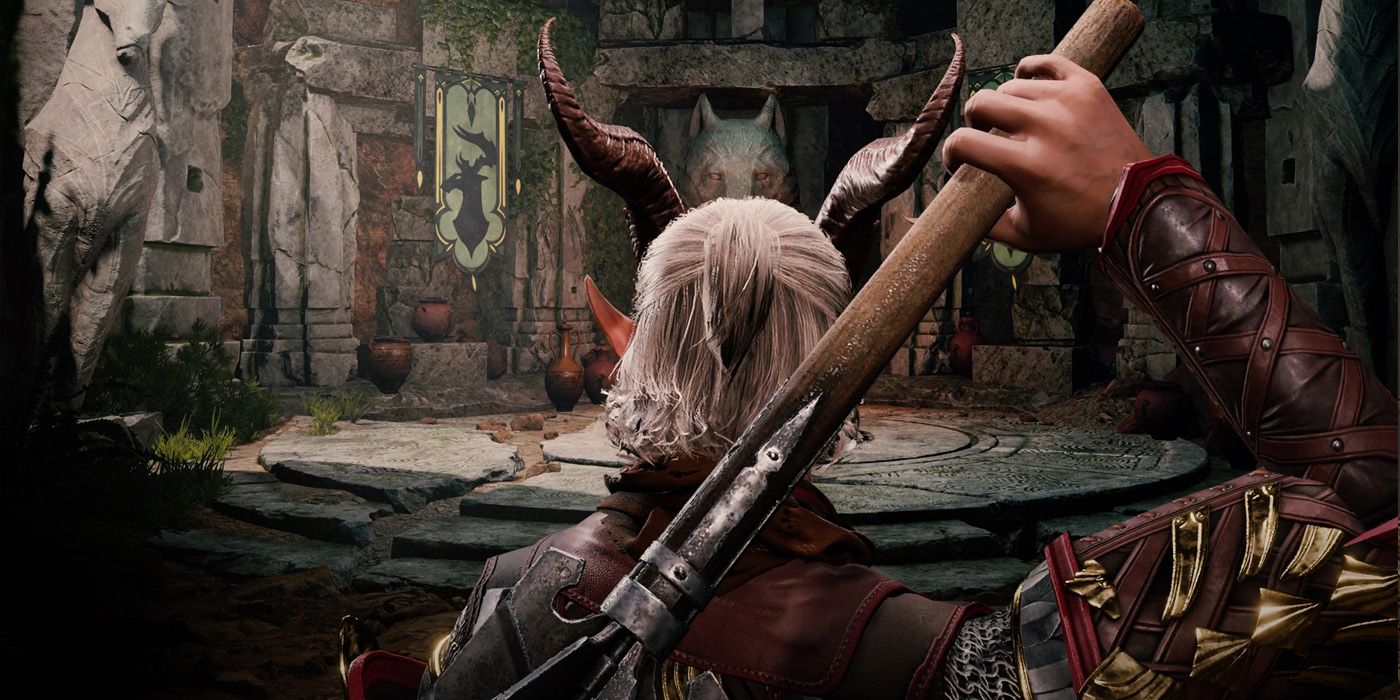
10 Pro Tips For Playing Dungeons & Dragons While Waiting For Baldur's Gate 3
If you're playing some D&D while waiting for Baldur's Gate 3, here are some tips to maximize the experience.
While this isn’t exactly the most ideal upgrade to a weapon, that damage addition can be quite crucial when facing multiple foes. Another useful way to circumvent this “disadvantage” is to add the Vicious Weapon upgrade on top of another Magi Item category, further enhancing the weapon.
How To Get Vicious Weapon
With an emphasis on violence, the Vicious Weapon may work with a more wrathful backstory. For instance, the Vicious Weapon may be a cursed armament that grants its wielder with an insatiable bloodlust. Likewise, it may serve as an unholy weapon of an Evil God like Asmodeus that lures its users into worshiping the demon lord completely through increasing acts of rage.
Vicious Weapon: How Does It Fit The Monastic Warrior?
Players can argue to the DM that the Vicious Weapon’s effect should also consider the 20s that are acquired through bonuses, especially with the item’s Rare value. However, even if DMs don’t consider this option, the +7 Damage on crit makes for a decent cherry on top especially since criticals deal double damage. When used with a Quarterstaff or Spear, alternating a Vicious Weapon with options such as Flurry of Blows can make a Monk much deadlier when creating combos.
11 Moon-Touched Sword
Moonlight Gives Flavor For A Thematic Sword
Rarity | Common |
|---|---|
Weapon Tree | Any Sword |
Bonus | - |
Effects | The unsheathed blade creates 15-foot of bright light and 15-foot dim light |
Any sword can become a Moon-Touched Sword when given to the right blacksmith - or perhaps an Elven enchanter. As a Moon-Touched Sword, the unsheathed blade will shed moonlight in dark dungeons, illuminating the space with light (15ft bright, 15ft dim).
Albeit without any significant damage boosts, a Moon-Touched Sword is a handy replacement for a torch and is a gateway to stronger Magic Weapons. While a Monk with high enough Dexterity can do wonders with a Moon-Touched Sword at early levels, this is best reserved until they get a more decent melee weapon with range.
How To Get Moon-Touched Sword
As a weapon that glows with the brightness of the moonlight, it’s normal to associate the Moon-Touched Sword with elves. Since it's a Common weapon, it could be a simple weapon wielded by an elven ranger regiment. It may also be an enchantment to the Monk’s sword that was granted by a nature-leaning spellcaster such as a Druid.
Moon-Touched Sword: How Does It Fit The Monastic Warrior?
Being a simple sword, the Moon-Touched Sword could simply take the form of a Longsword, granting it a base 1d8 Damage. Despite its “simple” take on a Monk weapon, it does imply that it’s better off as a sidearm or a starting armament before transitioning into Martial Arts. Having a sword that can become a torch substitute without many complications can make the Moon-Touched Sword worth using until players transition to more ideal weapons.
10 Wraps Of Unarmed Prowess
Transform Unarmed Attacks Into Magical Attacks
Rarity | Uncommon, Rare, Very Rare |
|---|---|
Weapon Type | Varies (Wondrous Item) |
Bonus | +1, +2, +3 |
Effects | Unarmed Strikes are now Magical |
Thanks to the Book of Many Things, the Monk in Dungeons & Dragons can finally use their unarmed melee attacks but classify them as magical strikes, courtesy of the Wraps of Unarmed Prowess. These are Wondrous Items that take the form of cloth wraps. When worn, the Monk’s unarmed attacks are now considered magical for the purposes of bypassing resistances to non-magical damage.
Not only that, the Wraps of Unarmed Prowess come with bonuses depending on their rarity, allowing players to enjoy as much as +3 to both Attack Rolls and Damage Rolls against foes. At higher levels, where Monks can access better damage dice for Flurry of Blows and other attacks, the bonuses from the Wraps can give them a much-needed advantage.
How To Get Wraps Of Unarmed Prowess
Given their original appearance as cloth wraps and the implication that they are specifically made for martial artists, it’s reasonable for Dungeon Masters to keep the Wraps of Unarmed Prowess inside monastic temples. A Monk’s mentor could be safeguarding these Wraps to give to the character as they make progress in their story arcs. Likewise, a Monk could find these Wraps as ordinary cloth from the ruins of a holy temple, where wrapping the cloth around their hands has provided them with an extraordinary sense of courage.
Wraps Of Unarmed Prowess: How Does It Fit The Monastic Warrior?
When used in early levels, even an ordinary Weapon +1 can outclass the Wraps of Unarmed Prowess. However, at higher levels, the Wraps of Unarmed Prowess can easily help the Monk push the limits of their Flurry of Blows throughout any combat encounter. The +2 and +3 to Attack Rolls and Damage Rolls can replace the +1d4 of traditional buffs, paving the way for much stronger bonuses from allies with offerings such as Improved Bardic Inspiration.
9 Delver’s Claws
Blindsight With Per Day Heal Makes For A Decent Weapon
Rarity | Rare (Requires Attunement) |
|---|---|
Weapon Type | Simple, Wondrous Item |
Bonus | - |
Effects |
|
When acquired, the Delver’s Claws appear like weatherworn leather gloves with large metal hooks, with the mountain rune stitched on the glove’s palm. From afar, the Delver’s Claws look like the claws of a mole, hence its name and effects. When equipped, this Wondrous Item acts as a Melee Weapon with Finesse and Light properties, and hits for 1d4 Slashing Damage.
However, what makes the weapon interesting are its other properties. Firstly, this weapon grants its users Blindsight up to 15 feet. This works in tandem with another bonus ability that lets players burrow at the same speed as their walking speed, giving them more mobility options in combat. Meanwhile, players can also invoke the mountain rune to get healing based on their CON Mod plus the result of rolling any number of unspent Hit Dice not greater than the player’s Proficiency Bonus.
How To Get Delver’s Claws
The nature-oriented origins of the Delver’s Claws may imply some ties to natural forces such as Druids or the fey, making a possible source for this item in Dungeons & Dragons lore take the form of a fairy sanctuary, a temple in the woods, or even a Druid grove. Likewise, the implication that the Delver’s Claws are manufactured means the weapon can be crafted, perhaps by a skilled leatherworker, in tandem with a Druid or even a Ranger who can bless it with the stitching of the mountain rune.
Delver’s Claws: How Does It Fit The Monastic Warrior?
Blindsight for 15 feet remains an effective tool against invisible foes. As Blindsight acts like Normal Vision without sight, a Monk with Delver’s Claws can use their “other” senses to even bypass general invisibility, giving them an edge in combat against pesky creatures that tend to “blend in” to surprise unsuspecting adventurers. The addition of a burrowing mechanic can diversify a Monk’s mobility options, allowing them to sneak up on enemies outside combat.
8 Weapon +1, +2, +3
Transform Any Weapon Into A More Aggressive Variant
Rarity | Uncommon, Rare, Very Rare |
|---|---|
Weapon Tree | Any Weapon |
Bonus | +1, +2, +3 |
Effects | - |
One could argue that Monks have their entire body as weapons at their disposal. Given the chance, a Weapon +1 can do wonders for a Monk following an early theme. With a Weapon +1, Monks get a +1 Bonus to Attack Rolls and Damage Rolls when attacking with this magic weapon. This bonus increases depending on the Weapon variant.
Monks who can get a Weapon +1 or its higher types should jump at the chance. With the +1 to +3 boost, an ordinary Spear or Quarterstaff can significantly increase their base damage output. While the bonuses won't apply to a Monk's Bonus Action abilities, the bonus to core attacks is plenty of help in early-level dungeons. Given their Uncommon nature, a skilled enough blacksmith can improve any weapon into its +1 variant.
How To Get Weapon +1, +2, +3
One can argue that the pluses attached to the Weapon +1, +2, and +3 can indicate the level of craftsmanship. Depending on the player table’s enchantment rules, a character can look for any blacksmith to improve the weapon they already have or have them craft a stronger weapon of their choice. A more thematic choice regarding a plus weapon would be looking for a famous blacksmith in the campaign’s world and having an armament forged specifically for the player’s character.
Weapon +: How Does It Fit The Monastic Warrior?
Ideally, Monks should only get up to Weapon +1 or Weapon +2 to augment their armaments for most attacks. While securing a Weapon +3 seems practical, Monks who can acquire Very Rare Magic Items should be at a point in their progression where their Unarmed Strikes should deal more damage.
7 Ring Of Spell Storing
Prepare Spells For Emergencies
Rarity | Rare (Requires Attunement) |
|---|---|
Weapon Tree | Ring |
Bonus | - |
Effects |
|
Depending on the player, a Ring of Spell Storing can become just as much an offensive asset as it could be a supportive item. One Ring of Spell Storing can hold up to 5 Levels of Spells. To store Spells, a Spellcaster simply needs to touch the Ring as they cast the Spell they want to deposit. When a user expands a Spell stored in the Ring, they use all the original properties (Slot Level, Save DC, Attack Bonus, Spellcasting Ability) from the original Spellcaster.

19 Pro Tips To Create A Cyberpunk D&D Campaign
While waiting for Cyberpunk 2077 to be released, here are 10 tips for putting together a cyberpunk Dungeons & Dragons campaign.
Most Monks would want to use the Ring to store Shield and Absorb Elements to boost their survivability. Offensive Monks can also store some of their favorite Spells (and even their comrades' Spells) in the Ring as emergency attacks.
How To Get Ring Of Spell Storing
Since the Ring of Spell Storing is more of a magic device than an actual weapon, Monks may acquire them from a spellcaster’s hoard of trinkets and magical artifacts. The ruined tower of a powerful Wizard could have this Ring as one of their many treasures, and this remains a popular route to acquire Magic Items. However, players could also try to have the team’s spellcaster or the local Wizard of the city center forge or create the Ring for them.
Ring Of Spell Storing: How Does It Fit The Monastic Warrior?
Despite the Monk’s potential for aggressive combat, their lack of natural defenses still makes them vulnerable to high-powered attacks. A Ring of Spell Storing equipped with Shield and Absorb Elements should give them additional defensive capabilities without having to wear armor. Doing this transforms the Ring of Spell Storing into pseudo-brass knuckles, as they still facilitate the Monk’s Unarmed Strikes.
6 Eldritch Claw Tattoo
Get Long-Ranged Options For The Melee Monk
Rarity | Uncommon (Requires Attunement) |
|---|---|
Weapon Tree | Wondrous Item (Tattoo) |
Bonus | +1 to Attack, Damage Rolls with Unarmed Strikes |
Effects |
|
What better weapon for a Monk than their entire body? With the Eldritch Claw Tattoo, a Monk can vastly improve their fighting potential. A Monk can obtain this in a secluded monastery or among the ranks of foreign magical travelers. While attuned to the Tattoo, the Monk gains a +1 Bonus to Attack Rolls and Damage Rolls. All unarmed strikes while attuned are considered magical when overcoming non-magical resistance.
The Eldritch Claw Tattoo also comes with Eldritch Maul, a new option for a Bonus Action. The Monk attuned to the Tattoo can reach enemies up to 15 feet away with both weapons and unarmed strikes. The hits done with Eldritch Maul get a 1d6 Force Damage boost.
How To Get an Eldritch Claw Tattoo
Magical tattoos in D&D add an element of novelty to cosmetics. A hand-to-hand combatant like the Monk could be more visually appealing with a sleek tat like the Eldritch Claw Tattoo. Given its darker themes, the Eldritch Claw Tattoo may be granted to the Monk as a curse after dealing with an entity from the beyond. Likewise, it could also be a “gift” from a suspicious Warlock after the party’s Monk has expressed the ambition to gain more power.
Eldritch Claw Tattoo: How Does It Fit The Monastic Warrior?
Being able to add extra effects to Unarmed Strikes enhances their potential as Magic Weapons. Its +1 to Attack and Damage Rolls alone significantly boosts the potency of Unarmed Strikes as attacks. However, its per-dawn Eldritch Maul that gives +1d6 Force Damage to melee attacks and a 15-foot attack range for 10 turns can transform the Monk into a mid-ranged pulverizer.
5 Javelin Of Lightning
Access Chain Lightning Through A Polearm
Rarity | Uncommon |
|---|---|
Weapon Tree | Javelin |
Bonus | - |
Effects | Command Word makes it a Bolt of Lightning. Releases a 5-foot wide line and extends to a target up to 120 feet. The Bolt recharges per dawn.
|
The Javelin of Lightning has all the base qualities of a regular Javelin. It deals 1d6 Piercing damage, with a Thrown property. Users can hurl the Javelin a distance of 30ft to 120ft. In the case of the Javelin of Lightning, the magic happens whenever the Monk throws it.
After speaking its Command Word, a thrown Javelin of Lightning becomes a literal 5-foot bolt of lightning. This bolt can hit a target up to 120 feet in a straight line, with all creatures in the line having to make a Dexterity Save to take half of 4d6 Lightning damage. If the Javelin hits its target, it takes the damage of the regular Javelin and the 4d6 Lightning damage. Given the theme of the Javelin, a Monk can acquire this from a Storm God or a place magically attuned with lightning.
How To Get Javelin Of Lightning
A Monk may be able to acquire this through an ordeal involving thunder and storms. The lightning-focused nature of the armament can mean an attachment to a lightning-based entity like a Storm Giant or even a God of Lightning. The athletic imagery associated with a javelin could link the acquisition of the Javelin of Lightning to some sort of martial display, such as a tournament.
Javelin of Lightning: How Does It Fit The Monastic Warrior?
At base, the Javelin’s 1d6 Piercing is identical to the Spear’s own damage numbers. However, the Javelin only having the Thrown property makes it inferior to the traditional Spear. Thankfully, the Javelin of Lightning precisely relies on the Javelin’s range to dish out damage.
4 Staff Of Striking
Get Decent Extra Damage For A Monk Weapon
Rarity | Very Rare (Requires Attunement) |
|---|---|
Weapon Tree | Staff |
Bonus | +3 to Attack, Damage Rolls |
Effects | 10 Charges, regains 1d6+4 Expended Charges at dawn. Expending the last Charge prompts a 1d20 Roll, where Roll 1 transforms staff into a nonmagical weapon
|
For all intents and purposes, the Staff of Striking functions as a regular Quarterstaff. Unlike its ordinary counterpart, the Staff of Striking has a +3 Bonus to Attack and Damage Rolls as well as 10 Charges for its effects. When attacking with the Staff, a Monk can expend up to three Charges to give an extra 1d6 Force damage to strikes per Charge spent. Charges get replenished at 1d6 + 4 Charges at dawn, with the risk of being turned into a regular Quarterstaff when all Charges are spent.
As a Very Rare Adventuring Gear, a Monk can obtain the Staff of Striking in the equivalent of an Adventurer's Guild in the campaign. They may also acquire the Staff of Striking in an ancient temple, or even in a monastery.
How To Get Staff Of Striking
A popular weapon associated with Monks in fiction, the Staff of Striking is a thematic weapon that could be acquired from a monastery. One could imagine that the local grandmaster or an expert in the player Monk’s Monastic Tradition may wield the Staff as a weapon of choice. The player can only be considered a master in their style by defeating this wielder and gaining possession of the weapon.
Staff Of Striking: How Does It Fit The Monastic Warrior?
The Staff of Striking’s basic properties as a Quarterstaff still give Monks the same 1d6/1d8 versatility of a Spear but lack the extra functionality of being thrown. Regardless, the Staff of Striking is a more potent staff with its innate +3 Attack/Damage bonus. Moreover, using its charges to deal up to 3d6 + 12 damage per turn within its charge limits can make for debilitating boss-only moves, especially when paired with Unarmed Strikes.
3 Staff Of Thunder And Lightning
Tap Into Special Attacks With A Staff
Rarity | Very Rare (Requires Attunement) |
|---|---|
Weapon Tree | Staff |
Bonus | +2 to Attack, Damage Rolls |
Effects | Using an effect makes it usable only after the next dawn:
|
As with the Staff of Striking, the Staff of Thunder and Lightning functions as a Quarterstaff. It gives a +2 Bonus to Attack Rolls and Damage Rolls, with five properties that are usable once per dawn. Due to its versatile nature and attunement to lightning, a Monk can acquire the Staff from a temple worshipping a Storm God. They may also have a powerful Wizard imbue and enchant a Quarterstaff to have its effects.
When used with its properties, this Staff can unleash extra 2d6 Lightning damage (Lightning), the potential to Stun an enemy (Thunder), unleash a line of lightning (Lightning Strike), release a Deafening thunder boom (Thunderclap), or a fusion of Thunderclap and Lightning Strike (Thunder and Lightning).
How To Get Staff Of Thunder And Lightning
It makes sense for the Staff of Thunder and Lightning to be locked behind a quest involving the storm. A Monk may be able to acquire this weapon after the party stops a Storm Elemental from ravaging the countryside with persistent thunderstorms, or stops an evil Wizard from using this very staff to wreak havoc in the town. Players could also opt for a more divine encounter, having this staff granted to the Monk player after swearing allegiance to a Storm God like Kord.
Staff Of Thunder And Lightning: How Does It Fit The Monastic Warrior?
Similar to Staff of Striking, the Staff of Thunder and Lightning at the base is simply a Quarterstaff +2 with extra bonuses. However, the Monk’s sheer lack of offensive ranged spells outside the Ways of the Sun Soul and Four Elements could make great use of this staff’s Thunderclap and Lightning Strike abilities for additional firepower.
2 Wyrmweaver Gauntlets
Multi-Range Gauntlets Diversify Monk Combat
Rarity | Very Rare (Requires Attunement) |
|---|---|
Weapon Type | Gauntlet, Wondrous Item |
Bonus | - |
Effects |
|
The Dungeons & Dragons lore of the Wyrmweaver Gauntlets states that they are seemingly built for brawlers to go toe-to-toe with fierce beasts of the sky, like dragons. In order to contend with the prowess of such creatures, the Wyrmweaver Gauntlets have the dragon rune engraved on the studded armaments.
What makes the Wyrmweaver Gauntlets interesting is how equipping them immediately grants +1d6 Force Damage to a Monk’s attacks on hit. Not only that, they can choose an elemental damage type to be resistant to once every Long Rest. Players who want their Monk to feel exceptionally powerful can invoke the dragon rune, conjuring two spectral fists to envelop the gauntlets as they now enable Monks to strike opponents from afar. Despite this only being possible for a minute once a day, the guaranteed +1d6 Force Damage at range can give Monks a much-needed dose of versatility against tougher mobs and even bosses.
How To Get Wyrmweaver Gauntlets
As weapons built precisely to hunt dragons and large beasts, the Wyrmweaver Gauntlets are likely tools that are common in isolated hunting societies or sacred heirlooms in the last remnants of Dragon Hunters in a campaign. The visual imagery here could be a village at the summit of a mountain, waiting to hunt dragons who try to descend and wreak havoc in the world below. A Monk can make a pilgrimage to such a mountain and use the Gauntlets to defeat a dragon and “earn” them as a permanent reward. Likewise, this could be among the more powerful endgame weapons a Monk might receive as a part of their personal arc.
Wyrmweaver Gauntlets: How Does It Fit The Monastic Warrior?
At its core, adding +1d6 Force Damage to attacks each turn on top of a per-day option of attacking at range allows the Wyrmweaver Gauntlets to diversify the Monk’s combat options. Being able to attack at range lets Monks tackle more threats simultaneously, and be at a safe distance against more dangerous foes in melee range. Conversely, the 30-foot reach of the Wyrmweaver Gauntlet’s rune effect allows Monks to defeat spellcasters from afar without overstepping deep into enemy territory, paving the way for more tactical plays.
1 Blood Fury Tattoo
Get A Lifesteal Melee Weapon
Rarity | Legendary (Attunement) |
|---|---|
Weapon Tree | Wondrous Item (Tattoo) |
Bonus | - |
Effects | Bloodthirsty Strikes
|
Staying true to the adage that the Monk's best weapon is their own body, the Blood Fury Tattoo is a fitting Wondrous Item. Due to its attunement to bloodthirst, a Monk may gain this through a brutal tournament, or perhaps while meeting with infamous magical mercenaries.
When attuned, the Blood Fury Tattoo gives the Monk access to Bloodthirsty Strikes. They gain 10 Charges of these attacks, all of which are replenished at dawn. Whenever the Monk attacks while attuned to the Tattoo, they can expend a charge to deal an additional 4d6 Necrotic damage to the opponent, and they gain the same damage dealt as HP. When a creature attacks the Monk, they can use a Charge and their Reaction to strike at an Advantage.
How To Get Blood Fury Tattoo
While the Blood Fury Tattoo has its own backstory in the rulebooks, DMs can repurpose it as a symbol etched into the Monk as a sign of an achievement or a curse. For instance, a Monk who showed viciousness in battle could be granted the Blood Fury Tattoo as a sign of their bravery. However, a more shocking twist would be a Monk being indoctrinated into a secret cadre of their Monastery dedicated to doing questionable things for the safety of the nation.
Blood Fury Tattoo: How Does It Fit The Monastic Warrior?
The Blood Fury Tattoo’s effects already make it worth acquiring, especially with its Reaction-based counterattack. However, its +4d6 Necrotic Damage (and heal) that costs a charge could be added after the hit is made, making this effect resemble a more powerful version of a Divine Smite. Moreover, since this effect essentially adds “extra damage,” this damage is doubled on a crit.

Dungeons and Dragons
- Original Release Date
- 1974-00-00
- Publisher
- Wizards of the Coast
- Designer
- E. Gary Gygax , Dave Arneson

